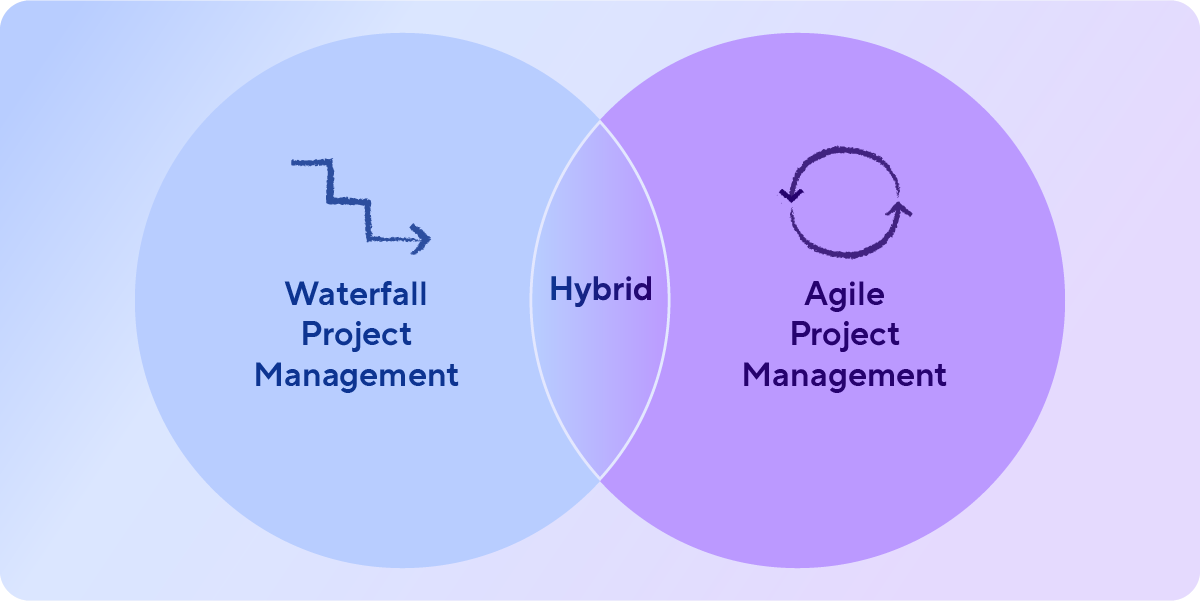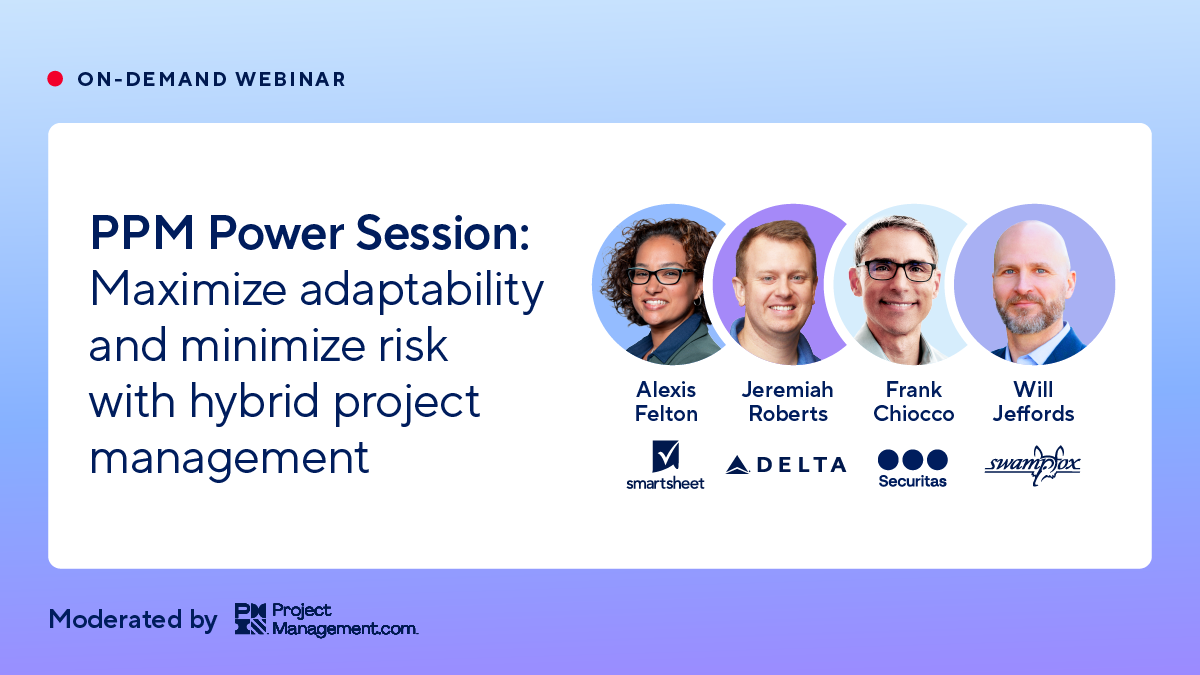Article
5 tips for adopting a hybrid project management approach
March 28, 2025
With 97% of PPM professionals reporting that they’ve experienced change in the workplace in the last year, it’s evident that there is more pressure than ever on organizations to maintain structure while embracing flexibility. That’s why more than 42% of project management teams are adopting a hybrid project management approach — a strategic approach that blends the best elements of Waterfall, Agile, and Lean methodologies to drive productivity while adapting to change. However, making the shift requires careful planning and the right mindset.

Smartsheet recently brought together four operational experts (Alexis Felton, a Senior Solutions Specialist at Smartsheet; Frank Chiocco, Director of the Program Management Office at Securitas; Jeremiah Roberts, the Continuous Improvement Manager at Delta Air Lines; and Will Jeffords, VP of Finance, HR, and PMO at Swampfox) from different industries to discuss their experience with hybrid project management in the third installment of our PPM Power Session Series. In this webinar, our speakers discussed their experience with embracing hybrid project management and shared five practical tips to help your team successfully adopt this approach, ensuring you get the benefits of both structure and adaptability. Let’s get started!
#1: Consider the why before the how: Set the foundation for hybrid success with thoughtful planning.
Hybrid project management isn’t a one-size-fits-all solution. Before making the transition to a hybrid methodology, consider taking a thoughtful change management approach. Alexis Felton encourages Project Managers to ask: “Is hybrid the right approach, or is it just the hot topic of the moment? Do we have the budget to train and enable a new approach? How is this going to affect the day-to-day of people who actually will be executing the work?” It’s important to consider your organization's culture and environment in order to outline the steps needed for a smooth adoption and avoid massive delays. By thoughtfully evaluating your organization's readiness, you can create a strategy that aligns with both your goals and your team’s capacity for change.
#2: One size does not fit all: Match the right methodology with the right project.
Not every project requires the same approach. Start by evaluating the nature of each initiative—whether it is exploratory and evolving, or whether it has clear, well-defined requirements. A detailed assessment upfront helps you tailor your methodology to the specific needs of the project. As Frank Chiocco puts it, “You determine your methodology project by project. If you conduct a detailed intake upfront and understand the type of project, that insight can help guide your approach.” This project-by-project evaluation enables teams to adopt the right framework at the right time. It also allows project managers to determine which initiatives require flexing between different methodologies to minimize risk and maximize efficiency. Jeremiah Roberts said, “Understanding the recursive focus on defining the problem and then getting into the design is one of the superpowers of hybrid."
Understanding the recursive focus on defining the problem and then getting into the design, is one of the superpowers of hybrid.
#3: Empower your team with clear communication: Provide clear reasoning for project management changes.
While the panelists come from different industries, communication plays a key role for all of them in helping their teams adapt and collaborate. Clear and consistent communication is the foundation of a successful hybrid approach. Without it, teams may struggle to understand why different methodologies are applied to different projects, leading to confusion and misalignment. “Communication and working with your people is key,” said Will Jeffords. “Communication is the key to make this (hybrid approach) work, absolutely.”
Transitioning to a hybrid approach can be complex, especially when teams are accustomed to a single, consistent approach. Frank Chiocco noted that adopting a hybrid approach can be “really confusing, so it requires a lot of sitting down and explaining to them [your team] the benefits of what that process is going to be.” Taking the time to explain why a specific approach is being used and how it aligns with project goals can help ease resistance and increase buy-in.
Communication and working with your people is key.
#4: Anticipate resistance and lead through it: Overcome friction with clarity and confidence.
Any shift in methodology can create resistance and transitioning to a hybrid approach is no exception. Teams and stakeholders may initially push back or feel confused when processes aren’t as clearly defined as they are in a traditional Waterfall framework. “It can be bumpy when you try a new methodology,” said Frank Chiocco. “Hybrid isn’t necessarily as clear as the other methodologies. I think the way around this is setting expectations very early… It’s all about education and making sure everyone understands their role on the project. The Project Manager has to take the driver’s seat and lead the team through whatever the process is.”
Hybrid isn’t necessarily as clear as the other methodologies. I think the way around this is setting expectations very early… It’s all about education and making sure everyone understands their role on the project. The Project Manager has to take the driver’s seat and lead the team through whatever the process is.
Setting clear expectations is key to managing this tension. Unlike Waterfall, the hybrid approach may not provide fixed deliverable dates or rigid timelines, so it’s important to establish familiar touchpoints — like milestones and progress checkpoints — to give stakeholders a sense of structure. “Hybrid and Agile are less familiar, which can create friction,” said Alexis Felton. “It’s very important to be clear with the intention up front, and then create the familiar guideposts for stakeholders…this helps temper the immediate resistance.”
At the same time, don’t be afraid to experiment. Hybrid project management thrives on flexibility, which means the first attempt might not be perfect. Felton encourages teams to lean into trial and error: “Be willing to try things and take risks.” Taking calculated risks and learning from early missteps will help refine the process and drive long-term success.
#5: Lead with confidence, adapt with flexibility: Build trust with your team while staying open to feedback.
Hybrid project management is about balance — and finding that balance takes time. When introducing a new methodology, it’s crucial for Project Managers to lead with both confidence and adaptability. Confidence fosters trust and alignment, while adaptability ensures your team feels supported throughout the transition. “The Project Managers really need to know what they are talking about because people are going to be looking at them for guidance,” said Frank Chiocco. “If you're wobbly on what you know… you're going to lose the team, and you're going to lose the stakeholders.”
Building trust requires more than just clear direction—it also means creating space for feedback and adapting when necessary. “When you’re implementing a change like this, you have to be willing to listen to ongoing feedback,” Felton says. “You can create tremendous advocates by listening to people, so don’t lose them along the way.”
Looking for more hybrid strategy insights?
Successfully adopting a hybrid project management approach requires thoughtful planning, clear communication, and adaptability. By evaluating each project individually, anticipating friction, and maintaining strong leadership with open feedback channels, your team can navigate complexities and strike the right balance between adaptability and predictability. Whether you’re new to hybrid project management or refining your approach, the key to success lies in balancing confidence with collaboration.


